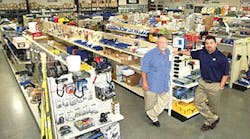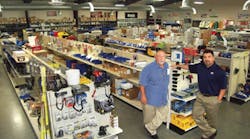Utility Trailer Sales of Southeast Texas has what few trailer dealers have — three facilities in the same metropolitan area.
All three are in the same quadrant of the Houston metro area. One, convenient to major truck dealers and leasing companies, is a freeway location that provides service, parts, and trailer sales. A second operation a few miles away contains a large parts showroom and also space for trailer sales.
The newest location, opened a year ago, is the most distinctive. It is a parts-only store that caters to the intermodal market.
The one-year-old intermodal store is in the eastern suburb of La Porte.La Porte, along with adjacent areas, is home to many petrochemical industrial plants that line the Houston Ship Channel — a 25-mile-long complex of diversified public and private facilities. La Porte also is gateway to the Port of Houston. The port has been ranked first in the United States in foreign waterborne tonnage for 14 consecutive years. It also is first in US imports for 19 consecutive years, and second in US export tonnage and total tonnage for 19 consecutive years.
One mile from the new Utility location is Barbours Cut Container Terminal, the primary container port in Houston for many years and the largest container terminal on the US Gulf Coast. The Port of Houston handles 69.6% of the containerized cargo market in the US Gulf, and 95.5% of the containers moved through Texas seaports. The six berths at Barbours Cut provide 6000 feet of continuous quay with 13 wharf cranes.
Five miles south is the $1.2 billion Bayport Container Terminal, which is being expanded to have a total of seven container berths with the capacity to handle 2.3 million TEUs.
The Port of Houston is made up of the Port of Houston Authority and the 150-plus private industrial companies along the Houston Ship Channel.
When Jonny Loring, president/general manager of Utility Trailer Sales of Southeast Texas, decided to open the facility in La Porte, he went out and hired Russell Sanders at parts manager, knowing that Sanders had over 20 years of experience selling to the intermodal industry.
“We sell daily to the port facilities,” Sanders says. “The intermodal businesses have chassis that carry containers. At this point, the repairs of the chassis and containers are handled by repair vendors inside and outside of the port areas. They have companies that have yards down here, like IMS or Maersk, and they work on equipment at those shops, and store boxes and chassis there. Two separate groups manage the chassis pool for the area — Gulf Consolidated Chassis Pool and Seacastle. They manage the maintenance and interchanges on the chassis. Terminals manage the boxes. And terminals repair both.
“We sell to the intermodal terminals themselves. In some cases, it's the steamship line, like Maersk, that we sell directly to. It's similar to a repair shop that would allow customers to store trailers there. Most of the facilities within the port have union employees associated with the International Longshoremen's Association. The service companies outside of the port are primarily non-union. We service both types of companies as a parts supplier.”
Twistlocks and latches
Utility Trailer Sales of Southeast Texas published a special hardware and accessories catalog specifically for the intermodal industry. Sanders describes the catalog as a “dictionary of intermodal and chassis parts.” He says it's a great tool because the “red, white, and blue logo goes a long way.” The top parts in terms of quantity sold are twistlocks and latches for chassis; container parts account for the most volume in dollars.
“We have quite a bit more product diversification here, compared to the other two Houston locations,” says Jeff Murillo, director of parts for Utility Trailer Sales Southeast Texas. “Russell has a strong retail background, so he has the green light to give just about any product a try that will attract the local marketplace.
“Our main goal is to get customers into the store, because with our brand name, we are associated with trailers and nothing else. We're very proud of our partnership and alignment with Utility Trailer Manufacturing, but when we go to market from the aftermarket standpoint, we approach it as an independent warehouse distributor to where we're in the heavy-duty parts business. With this store, we're going into a little extra — the container and chassis business, which is new to us, and also industrial supplies. That's something we haven't done at other stores. We catered this store to the market and to the manager who runs the place.
“It's a constant change in regards to trying new things. We're always going to have our core business. We're not ever going to get away from trailer parts. But we're seeing what else we can branch out into. We're not going to bring in men's clothing any time soon. But if it's within our market, we carry it. Here, because of our proximity to the petrochemical industry and the port facilities being safety-conscious, these products are going to sell.”
He says their parts sales are being driven by stricter maintenance standards and increased auditing of subcontractors, both of which are driving the desire to get better parts with a quality warranty, rather than just the cheapest import part available.
“Safety is a big factor at the ports and plants here,” Sanders says. “We sell safety products like vests and hats. We have rubber boots, gloves, and ponchos as well as safety clothing on wall hangers. Items like hard hats and welding hoods we display in a case next to the front counter, along with higher-priced merchandise like tools and flashlights. Recently we started carrying CB radios. I really didn't know whether they would sell, but drivers use them in plants and at the Port of Houston to converse with the person directing traffic.”
To further serve the intermodal customers, the store helped the Gulf Consolidated Chassis Pool conduct a research project in which they collected the lights that were replaced at various repair facilities.
“We went around to the GCCP repair vendors as we delivered parts, picked up the lights, and separated thousands of them by manufacture and type of light, and then we looked at each one and had a manufacturer's rep answer whether it was a warrantable light,” Sanders says..
Large retail area
The store carries a full line of trailer parts, including brakes, suspensions, body parts, roof panels, flooring, and lighting. Truck parts inventoried at the La Porte location include starters, alternators, clutches, and in-frame engine kits. Most of the orders are delivered on two trucks: a Ford F-450 with a 16-foot stake bed and 15,000-pound capacity, and a half-ton Chevrolet pickup.
The La Porte location maintains a $750,000 inventory. The bulk of it is kept inside the 10,500-square-foot retail showroom. The remainder of the inventory is stored in a 7,900-sq-ft warehouse.
There are 3,500 part numbers inventoried. Sanders says turns initially were slow because it was a new store but now are increasing, and he expects just over five turns a year starting at the end of this year. The store experienced double-digit sales increases every month, with 20% growth starting in June.
“The industry has been stagnant as a whole, but being a new location, it's easy to grow,” Sanders says. “Any growth is good growth. As soon as we opened, we had open account business that we regularly delivered to. Although the walk-in traffic was initially slow, it has picked up substantially.”
Utility recently bought the only other property on the block — a 2,400-square-foot metal building (formerly a body shop) that will be gutted and connected to the warehouse with a ramp. The warehouse is stacked high with suspensions and axles.
Increasing showroom traffic
Utility encouraged walk-ins by doing three things:
-
Putting products out in front of the store, such as headache racks, to draw attention.
-
Letting the managers of trucking companies know that their drivers could receive a discounted fleet rate, rather than the retail rate. “We're getting more and more trucking companies, which is really encouraging, with owner-operators coming in and buying maintenance parts because a lot of them work on their own trucks.”
-
Holding a grand opening in May that drew an overflow crowd of 800. “We had not only the mechanics and parts buyers for different locations, but secretaries and truck drivers.”
“There is such an increase in the amount of foot traffic at this new location, and we are steadily growing every month,” Loring says.
Sanders believes they can compete with anyone due to their ability to service the area and an aggressive sales force. Utility currently has four sales people canvassing Houston and the surrounding areas.
“My goal is to catch up with the other locations in sales volume,” Sanders says. “We're getting there. It's been fun. You get a little competition going, it always helps. When I worked for the competition, Utility had the Blaffer location and was going to build a place six miles away on Wallisville Road. Everybody was concerned it would affect our sales. I remember saying that it would encourage sales because it would bring more traffic to the area. And that's exactly what it did. Competition doesn't hurt. In my 30 years in the business, I have learned an important lesson. It is good to get out of your comfort zone and try new things. Be innovative and your business will be rewarded.”
Staying cutting edge
The Lorings — Jonny and his father, Jon, CEO of Utility Trailer Sales of Southeast Texas — have always kept an eye on markets and real estate. They knew there was nobody in this market — at least a player that would go to market like this.
“We thought if we could capture this market and prevent those customers from going all the way into town and provide the same level of service we do at our other stores, we could make it easier for them to do business with us,” Murillo says. “This is a prime location. We have 3,800 trucks that run through this intersection a week. It is the most expensive piece of property the dealership has ever bought, but we have an ideal location and great exposure. We thought that would do it.
“When we opened the store on Wallisville Road, six miles from our Blaffer store, a lot of people thought we were crazy. How do you open up two stores in such close proximity? But we were going more with a retail-oriented approach instead of a more delivery-type of service. We found out we captured more of that traditional owner-operator business instead of the larger fleets saying, ‘Look, I'm going to send you an order. You process it and deliver it to us. Just send it to me, send me my invoice, and I'll go about my business.’ Here, we're still doing it. We're not getting away from it. But we want the customer to come in and do some shopping.”
The Lorings considered having a shop at the facility, but they couldn't find a large enough piece of property that was available. They thought about shrinking the retail area to provide enough room for a few bays, but they decided against it.
The location has stocked and sold a limited quantity of trailers and expects to sell more trailers when the supply increases. Utility La Porte has a two-acre spread, with 100% of the surface in concrete.
“We've had a good trailer sales year,” Sanders says. “Used trailer inventory is rather hard to get right now. We will continue to sell trailers, and we'll have a full-time trailer salesman here soon. As a parts manager, I like having flatbeds on the lot because they provide a great display area for our headache racks and other merchandise.”










